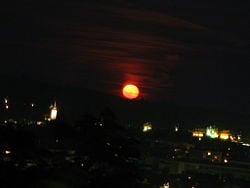Difference between revisions of "Moon illusion" - New World Encyclopedia
(Images OK) |
|||
| Line 1: | Line 1: | ||
| − | {{Claimed}}{{Started}}{{Contracted}} | + | {{Claimed}}{{Started}}{{Contracted}}{{Images OK}} |
[[Category:Politics and social sciences]] | [[Category:Politics and social sciences]] | ||
[[Category:Psychology]] | [[Category:Psychology]] | ||
| − | + | [[Image:Fdecomite - Moon and Venus at sunset (by).jpg|right|250px|thumb|High up in the sky, the moon appears smaller.]] | |
| − | The '''Moon illusion''' is a visual illusion (or [[optical illusion]]) in which the [[Moon]] appears larger near the [[horizon]] than it does while higher up in the [[sky]]. This optical illusion also occurs with the [[Sun]] and [[constellation | + | [[Image:IMG 0573 - Graz - View from Schlossberg.JPG|right|250px|thumb|When the moon is close to the horizon, it appears to be much larger.]] |
| + | The '''Moon illusion''' is a visual illusion (or [[optical illusion]]) in which the [[Moon]] appears larger near the [[horizon]] than it does while higher up in the [[sky]]. This optical illusion also occurs with the [[Sun]] and [[star]] [[constellation]]s. | ||
==Discovery== | ==Discovery== | ||
| − | The moon illusion is seemingly as old as history itself. References to the moon illusion can be found as early as the seventh century B.C.E., and is mentioned in early Greek and Chinese writings. Aristotle also mentioned it in 250 B.C.E.<ref>Simanek, | + | The '''moon illusion''' is seemingly as old as history itself. References to the moon illusion can be found as early as the seventh century B.C.E., and is mentioned in early Greek and Chinese writings. [[Aristotle]] also mentioned it in 250 B.C.E.<ref>Donald Simanek, [http://www.lhup.edu/~dsimanek/3d/moonillu.htm "The Moon Illusion, An Unsolved Mystery"] Jan 11, 2002. Retrieved October 16, 2007.</ref> |
==Description== | ==Description== | ||
| − | |||
| − | |||
| − | |||
| + | When looking at the [[moon]] while it is high overhead, it appears to be significantly smaller than when it is close to the horizon. In many instances, it is difficult to convince people that the moon has remained the same size without proving it to them. The constant size of the moon irregardless of its position in the sky can be proven using a [[theodolite]], or by the much simpler method of holding a small [[coin]] at arm's length. The coin will cover the same amount of the moon no matter where the moon is in the sky. The [[illusion]] also becomes much less convincing when the horizon moon is viewed upside down (for instance, by bending over and viewing the moon through one's legs.) | ||
==Explanation== | ==Explanation== | ||
| − | It is sometimes thought that the moon appears larger near the horizon as a result of some kind of [[magnification]] effect caused by the [[Earth's atmosphere]]. This is not true, although the atmosphere does change the [[color]] of the moon. The moon does appear slightly more ovoid in shape near the horizon, due to the weak [[prism]] effect of the atmosphere, but does not change significantly in size. Any change in size is a ''perceived'' change, not an actual visual change, and therefore cannot be attributed to atmospheric conditions. | + | [[Image:GoldenMedows.jpg|left|250px|thumb|Clouds near the horizon are typically farther away from the viewer, while those high in the sky are closer, giving the impression of a flat, or gently curved, sky surface]] |
| + | It is sometimes thought that the moon appears larger near the horizon as a result of some kind of [[magnification]] effect caused by the [[Earth]]'s [[atmosphere]]. This is not true, although the atmosphere does change the [[color]] of the moon. The moon does appear slightly more ovoid in shape near the horizon, due to the weak [[prism]] effect of the atmosphere, but does not change significantly in size. Any change in size is a ''perceived'' change, not an actual visual change, and therefore cannot be attributed to atmospheric conditions. | ||
| − | [[ | + | One of the oldest explanations for the moon illusion is the apparent distance theory, which was first clearly described by [[Cleomedes]] around 200 C.E. This theory proposes that we tend to perceive the sky as more or less a surface, but unlike a hemispherical surface, it does not seem to be equally distant from us at all points. When we see clouds, birds, and airplanes in the sky, those near the horizon are typically farther away from us than those overhead. If we see an airplane overhead, its image gets smaller and smaller as it nears the horizon. This results in the perception of the sky as a fairly flat surface. In other words, we perceive the sky near the horizon to be farther away than the sky overhead. This theory is usually illustrated by the well-known drawing of the "flattened sky dome." This theory is related to the [[Ponzo Illusion]], where a shape placed higher up on converging lines appears to be larger than a shape placed lower down. Because of perspective and distance cues, we expect shapes that are further away to be smaller; because of this, shapes that are the same size appear to be larger than they actually are. |
| − | One of the | + | One of the problems with the apparent size theory is that, in addition to the moon looking larger, it should theoretically also look farther away. In reality, most people perceive the moon as not only being larger when it is close to the horizon, but also nearer. To explain this, some use the "relative size hypothesis," which suggests that the perceived size of an object depends partly on the size of objects in its immediate visual environment. Thus, any trees or buildings visible in the vicinity of the moon make the moon appear larger. |
| − | + | A more recent explanation regarding the moon illusion was proposed by Don McCready of the University of Wisconsin. McCready suggests that the illusion is due to [[oculomotor macropsia]] and [[oculomotor micropsia]]. Oculomotor macropsia causes object to appear larger when they appear far away based on distance cues such as buildings or trees. Oculomotor micropsia makes objects appear smaller when we perceive them to be closer. Oculomotor micropsia exists in order to make it easier and faster to turn our heads the right amount to perceive a nearby object that might pose a threat. Oculomotor macropsia exists because it is a necessary byproduct of using oculomotor micropsia, and there is no harm done if we misperceive an object that is far away.<ref>Lee Krystek, [http://unmuseum.mus.pa.us/exmoon.htm "Experiment in Perception: The Ponzo Illusion and the Moon"] 1998. Retrieved October 16, 2007.</ref> | |
| − | |||
| − | |||
==Applications== | ==Applications== | ||
| − | The moon illusion, like many visual and perceptual | + | The moon illusion, like many visual and perceptual [[illusion]]s, helps scientists formulate theories on how images are perceived and processed. In addition to scientific study, the moon illusion has probably done more than any other illusion to inspire a sense of wonder and amazement at the natural world, particularly in poets and artists. |
==Notes== | ==Notes== | ||
| Line 37: | Line 35: | ||
==External links== | ==External links== | ||
| + | All links Retrieved November 12, 2007. | ||
* [http://facstaff.uww.edu/mccreadd/index.html A vision scientist reviews and critiques moon illusion theories.] | * [http://facstaff.uww.edu/mccreadd/index.html A vision scientist reviews and critiques moon illusion theories.] | ||
* [http://www.lhup.edu/~dsimanek/3d/moonillu.htm A physicist reviews past and current theories] | * [http://www.lhup.edu/~dsimanek/3d/moonillu.htm A physicist reviews past and current theories] | ||
| Line 43: | Line 42: | ||
* [http://www.archimedes-lab.org/moon_illusion/moon.html Inflatable Moon (explanation of an early illusion)] | * [http://www.archimedes-lab.org/moon_illusion/moon.html Inflatable Moon (explanation of an early illusion)] | ||
* [http://www.enane.de/empirhyp.htm Explanation visual gestalt effects, which may also apply to the moon illusion] | * [http://www.enane.de/empirhyp.htm Explanation visual gestalt effects, which may also apply to the moon illusion] | ||
| − | * [http://www.straightdope.com/classics/a2_110.html Why does the Moon appear bigger near the horizon?] (from | + | * [http://www.straightdope.com/classics/a2_110.html Why does the Moon appear bigger near the horizon?] (from The Straight Dope) |
* [http://www.netaxs.com/~mhmyers/moon.tn.html#moonillusion Moon illusion illustrated] | * [http://www.netaxs.com/~mhmyers/moon.tn.html#moonillusion Moon illusion illustrated] | ||
| − | |||
*[http://niquette.com/books/sophmag/moonill.htm Four Answers to the Why Question about the Moon Illusion] | *[http://niquette.com/books/sophmag/moonill.htm Four Answers to the Why Question about the Moon Illusion] | ||
*[http://antwrp.gsfc.nasa.gov/apod/ap020130.html APOD Moon Illusion page] | *[http://antwrp.gsfc.nasa.gov/apod/ap020130.html APOD Moon Illusion page] | ||
| − | |||
| − | |||
| − | |||
| − | |||
{{Credits|Moon_illusion|156737864|}} | {{Credits|Moon_illusion|156737864|}} | ||
Revision as of 22:25, 12 November 2007
The Moon illusion is a visual illusion (or optical illusion) in which the Moon appears larger near the horizon than it does while higher up in the sky. This optical illusion also occurs with the Sun and star constellations.
Discovery
The moon illusion is seemingly as old as history itself. References to the moon illusion can be found as early as the seventh century B.C.E., and is mentioned in early Greek and Chinese writings. Aristotle also mentioned it in 250 B.C.E.[1]
Description
When looking at the moon while it is high overhead, it appears to be significantly smaller than when it is close to the horizon. In many instances, it is difficult to convince people that the moon has remained the same size without proving it to them. The constant size of the moon irregardless of its position in the sky can be proven using a theodolite, or by the much simpler method of holding a small coin at arm's length. The coin will cover the same amount of the moon no matter where the moon is in the sky. The illusion also becomes much less convincing when the horizon moon is viewed upside down (for instance, by bending over and viewing the moon through one's legs.)
Explanation
It is sometimes thought that the moon appears larger near the horizon as a result of some kind of magnification effect caused by the Earth's atmosphere. This is not true, although the atmosphere does change the color of the moon. The moon does appear slightly more ovoid in shape near the horizon, due to the weak prism effect of the atmosphere, but does not change significantly in size. Any change in size is a perceived change, not an actual visual change, and therefore cannot be attributed to atmospheric conditions.
One of the oldest explanations for the moon illusion is the apparent distance theory, which was first clearly described by Cleomedes around 200 C.E. This theory proposes that we tend to perceive the sky as more or less a surface, but unlike a hemispherical surface, it does not seem to be equally distant from us at all points. When we see clouds, birds, and airplanes in the sky, those near the horizon are typically farther away from us than those overhead. If we see an airplane overhead, its image gets smaller and smaller as it nears the horizon. This results in the perception of the sky as a fairly flat surface. In other words, we perceive the sky near the horizon to be farther away than the sky overhead. This theory is usually illustrated by the well-known drawing of the "flattened sky dome." This theory is related to the Ponzo Illusion, where a shape placed higher up on converging lines appears to be larger than a shape placed lower down. Because of perspective and distance cues, we expect shapes that are further away to be smaller; because of this, shapes that are the same size appear to be larger than they actually are.
One of the problems with the apparent size theory is that, in addition to the moon looking larger, it should theoretically also look farther away. In reality, most people perceive the moon as not only being larger when it is close to the horizon, but also nearer. To explain this, some use the "relative size hypothesis," which suggests that the perceived size of an object depends partly on the size of objects in its immediate visual environment. Thus, any trees or buildings visible in the vicinity of the moon make the moon appear larger.
A more recent explanation regarding the moon illusion was proposed by Don McCready of the University of Wisconsin. McCready suggests that the illusion is due to oculomotor macropsia and oculomotor micropsia. Oculomotor macropsia causes object to appear larger when they appear far away based on distance cues such as buildings or trees. Oculomotor micropsia makes objects appear smaller when we perceive them to be closer. Oculomotor micropsia exists in order to make it easier and faster to turn our heads the right amount to perceive a nearby object that might pose a threat. Oculomotor macropsia exists because it is a necessary byproduct of using oculomotor micropsia, and there is no harm done if we misperceive an object that is far away.[2]
Applications
The moon illusion, like many visual and perceptual illusions, helps scientists formulate theories on how images are perceived and processed. In addition to scientific study, the moon illusion has probably done more than any other illusion to inspire a sense of wonder and amazement at the natural world, particularly in poets and artists.
Notes
- ↑ Donald Simanek, "The Moon Illusion, An Unsolved Mystery" Jan 11, 2002. Retrieved October 16, 2007.
- ↑ Lee Krystek, "Experiment in Perception: The Ponzo Illusion and the Moon" 1998. Retrieved October 16, 2007.
ReferencesISBN links support NWE through referral fees
- Hershenson, Maurice. "The Moon Illusion" November 1989. Lawrence Erlbaum. ISBN 0805801219.
- Long, Kim. "The Moon Book: Fascinating Facts About the Magnificent, Mysterious Moon" August 1998. Johnson Books. ISBN 1555662307.
- Ross HE and Plug C. The mystery of the moon illusion: Exploring size perception 2002. Oxford University Press. ISBN 0-19-850862-X.
External links
All links Retrieved November 12, 2007.
- A vision scientist reviews and critiques moon illusion theories.
- A physicist reviews past and current theories
- Summer Moon Illusion - NASA
- Why does the moon look so big now?
- Inflatable Moon (explanation of an early illusion)
- Explanation visual gestalt effects, which may also apply to the moon illusion
- Why does the Moon appear bigger near the horizon? (from The Straight Dope)
- Moon illusion illustrated
- Four Answers to the Why Question about the Moon Illusion
- APOD Moon Illusion page
Credits
New World Encyclopedia writers and editors rewrote and completed the Wikipedia article in accordance with New World Encyclopedia standards. This article abides by terms of the Creative Commons CC-by-sa 3.0 License (CC-by-sa), which may be used and disseminated with proper attribution. Credit is due under the terms of this license that can reference both the New World Encyclopedia contributors and the selfless volunteer contributors of the Wikimedia Foundation. To cite this article click here for a list of acceptable citing formats.The history of earlier contributions by wikipedians is accessible to researchers here:
The history of this article since it was imported to New World Encyclopedia:
Note: Some restrictions may apply to use of individual images which are separately licensed.


